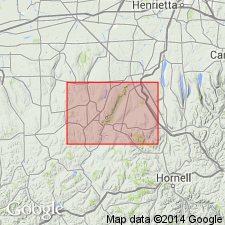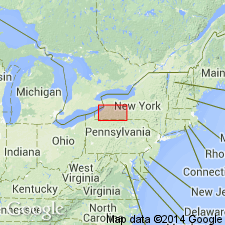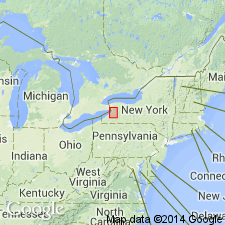
- Usage in publication:
-
- Nunda sandstone
- Modifications:
-
- Original reference
- Dominant lithology:
-
- Sandstone
- AAPG geologic province:
-
- Appalachian basin
Summary:
Pg. 61. Nunda sandstone. Is introduced to replace "Portage sandstones," the upper terminal member of Portage group as defined by Hall. In Portage and Nunda quadrangles, the formation consists of 215 feet of light blue-gray sandstone in layers 3 to 10 feet thick, some of which are calcareous. Is only part of Portage group that can be said to be fairly well exposed in town of Nunda, and only to these sandstones can name Nunda with any propriety be applied. Is overlain by Wiscoy shales and sands, which paleontologically belong to Portage group. Underlain by Gardeau flags and shale.
Source: US geologic names lexicon (USGS Bull. 896, p. 1521).

- Usage in publication:
-
- Nunda sandstone*
- Modifications:
-
- Overview
- AAPG geologic province:
-
- Appalachian basin
Summary:
The name Nunda sandstone was also applied to †Portage sandstone by Luther in 1911 (New York State Mus. Bull., no. 152, p. 22), Hartnagel, 1912 (New York State Mus. Hdbk., no. 19), Luther 1914 (New York State Mus. Bull., no. 172, p. 27), and Chadwick, 1919 (GSA Bull., v. 30, p. 157), 1920 (idem, v. 31, p. 118) and 1922 (idem, v. 34, p. 68-69). The use of Nunda for Portage group was generally abandoned many years ago. In 1933 (Pan-Amer. Geol.) and 1935 (GSA Bull), however, G.H. Chadwick adopted Nunda for the group and Portage for the sandstone. (See under Portage group.) W. Goldring, 1931 (New York State Mus. Hdbk., no. 10, p. 369, 402, etc.), used Nunda for the sandstone and Portage for the group.
The USGS now [ca. 1938] treats Nunda sandstone as a formation, underlying Wiscoy shale and overlying West Hill formation (=Gardeau shale to east). This is also present [ca. 1938] usage of New York State Survey.
Source: US geologic names lexicon (USGS Bull. 896, p. 1521).

- Usage in publication:
-
- Nunda sandstone member*
- Modifications:
-
- Revised
- AAPG geologic province:
-
- Appalachian basin
Summary:
Nunda sandstone of Clarke and Luther (1908) redesignated as sandstone member of West Falls formation (new). Thickness ranges from 2 to 225 ft. In western Wyoming Co. occupies interval of 28 ft but is divided into two parts by tongue of Angola shale member. In Genesee River Valley-Letchworth Park area, overlies West Hill member and underlies Pipe Creek member of Hanover shale. In Naples-Hammondsport area, overlies West Hill member and underlies Wiscoy sandstone. Age is Late Devonian.
Source: GNU records (USGS DDS-6; Reston GNULEX).

- Usage in publication:
-
- Nunda Member
- Modifications:
-
- Overview
- AAPG geologic province:
-
- Appalachian basin
Summary:
In western NY, the Nunda Member of the West Falls Formation generally includes two packets of sandstone beds--one at the base and one near the top. Total number of sandstone beds varies from one to eight and total thickness varies from 0 to 38 m. Authors include in the Nunda the intertonguing shales of the Angola for ease of analysis. Unit is most likely a submarine fan deposit as the sandstones are generally thick, massive to wavy/flaggy-bedded, have few primary sedimentary structures, terminate abruptly, and appear to have lobate forms.
Source: GNU records (USGS DDS-6; Reston GNULEX).
For more information, please contact Nancy Stamm, Geologic Names Committee Secretary.
Asterisk (*) indicates published by U.S. Geological Survey authors.
"No current usage" (†) implies that a name has been abandoned or has fallen into disuse. Former usage and, if known, replacement name given in parentheses ( ).
Slash (/) indicates name conflicts with nomenclatural guidelines (CSN, 1933; ACSN, 1961, 1970; NACSN, 1983, 2005, 2021). May be explained within brackets ([ ]).

